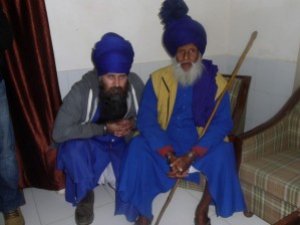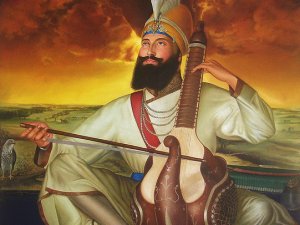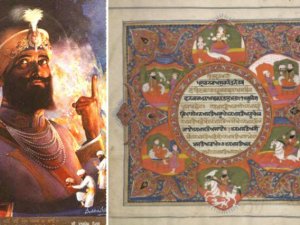Editor's note: This is the 2nd section of a long scholarly work which includes: 1) Translation of the entire Jāpu Sāhib with Roman transliteration 2) History of The Jāpu Sāhib 3) Theme 4) Invocation and nom de plume 5) Metres and structure 6) Praxis 7) Manuscripts 8) Authenticity
Click here for the entire document of which this is one section.
The Jāpu Sāhib was the first piece to be composed by the Guru at Anandpur Sahib in 1734 VS/1677 AD. Chaupa Singh (1700) narrates that the Guru dictated the composition himself (āpaṅī) first, when he was about sixteen years of age.18 Obviously this is why the Jāpu Sāhib is the first composition in the Dasam Granth Sahib.19 The Jāpu Sāhib denotes the rhythmic praises of God to be repeated, or meditated upon (Japu) and is for bhaktī but the quality of vīr ras is strongly conveyed. The language is mainly Braj Bhāshā with some sections using names for God in Persian also employing Arabic, like Allah, Rahīm, Karīm as well as other portions employing Prakrit and Sanskrit, like Parmesvar, Gobind, etc.20 The Jāpu Sāhib serves as a general invocation at the beginning of the Dasam Granth Sahib. It has parallels with the Jap of Guru Nanak, the first composition in the Adi Guru Granth Sahib.
Guru Nanak bows to Vahiguru, ādesu tisai ādesu, and this same devotion is continued on by the Tenth Nanak - Guru Gobind Singh. Like the Jap jī Sāhib, the Jāp Sāhib is written in metres or chhaṅds. While Guru Nanak does not label the metres, Guru Gobind Singh does, giving them new names to show their style of movement. Like the Mῡl mantra, the first verse Chhappai Chhaṅd Tva Prasādi states that Vahiguru has no features, caste, lineage etc. The Guru states that his purpose of this composition is to ‘praise You by your active names’ (karam nām), God’s shaktī or power! In the next Bhujaṅg Prayāt Chhaṅd, the Metre of the Fast Moving Cobra (Chhaṅd seems to be from the same root as the English word chant). The Guru bows to the Creator by repeating the word Namastvaṅ – Namaskār Tvaṅ/taṅ - Tva ṅῡ – I bow to You. The first attribute being beyond death, or Akal!
The Jāp Sāhib was written at Bhagpura in the vicinity of Anandpur Sahib. It was here that the Guru recited this bīr ras bāṇī, whilst his warriors were practicing Gatka/Shastravidia and horse riding. In this bāṇī, there are many allusions to the khaṅḍ e-ki-pāhul or Amrit sanāchār just like the Jap jī Sāhib – where the Guru talks about how to process the amrit before the salok. In the Jāp Sāhib we also have the stanza of the Bhagwatī or Bhagautī the Khaṅḍā (Double-Edged Sword), of sweetness, of water - Madhubhār and so on. There are also direct references to fighting Charpaṭ and Bhujaṅg Prayāt Chhaṅd. The Guru made the community into Saint Warriors, and ends this exciting, powerful, rhythmic bāṇī, with Sadā Aṅg Saṅge, which means that Vahiguru is in us, and all around us. Like Jap jī Sāhib is the first bāṇī of Adi Guru Granth Sahib ji Maharaj, the Jāpu Sāhib is the first bāṇī of the Dasam Granth Sahib.
Model of Dasam Granth Sahib
Like the Guru Granth Sahib the Dasam Granth Sahib has a structure, which after Guru Gobind Singh, was organised into the correct order by his trusted official, Bhai Mani Singh. Bhai Mani Singh writes in is Bhagat Ratnāwālī that the bāṇī is amrit mai bāṇī (ambrosial verses) – like Jāp Sāhib, Judh mai bāṇī like Bachitra Nāṭak Sāhib (war verses), Giān mai bāṇī, Saṅsar mai bāṇī like Charitropakyan Sāhib (knowledge and worldly verses). In Bhai Mani Singh’s hand written recension of Dasam Granth Sahib, which has eight folios in Guru Gobind Singh’s own hand (daskhat), he arranged the bāṇī accordingly to the char padarath (or four boons):
Moksha – Liberation - Jāp Sāhib and Akāl Ustati Sāhib
Dharam – Righteous War - Dharam Yudh – Bachitra Nāṭak Sāhib, Shastra Nām Mālā - the narratives of war and weapons which is major feature of all of compositions in Dasam Granth Sahib.
Ārth – Worldly Assets - Ardās (Chaṇḍī dī Vār)
Kām – Desires - Charitropakhyan Sāhib.
When we read traditional accounts we can conclude the following about the history of the Dasam Granth Sahib. One day a large group of Sikhs were looted whilst going to see the Guru. The Guru said ‘why has no Sikh ever said we have looted the Moghuls?’ Around the same time a messenger came to the Guru saying that the Sodhis refused to hand over the ‘Kirtarpurī bīrh of the Adi Granth, as the tradition narrates that the Guru wished to finalise the compilation with his fathers bāṇī. The Guru then said ‘I will compose such a scripture to complement the meekness that a Sikh receives on reading Adi bāṇī, so that the Sikhs are able to sustain their fighting spirit after me.’ After that point the Guru asked people to bring scriptures, arms and horses to him, hence the mention of war and its apparatus, like in his Jāp Sāhib and Svaiye Sāhib is found throughout the Sri Dasam Granth Sahib.21
------------------------------------------------------------------
18 P. S. ‘Padam’, ed., Rahitnāme, 4th edn., Amritsar: Bhai Chatar Singh Jivan Singh, 1989, p. 94:
saṁmata 1734 jāpu āpanī rasanī ucāra kītā. srī akāla usatati ucārī. srī mukhavāka savaiye uchāre.
19 Guru Gobind Singh, Jāpu Sāhib, Dasam Granth Sahib, pp. 1-10.
20 Gobind Singh Manusukhani, ‘A Study of the Sikh Scriptures’ The Sikh Review, July 1982, p. 26
21 See, The History of the Nitnem Bania by Akal Dr Kamalroop Sing Nihang. For more details see my publication with Mann here





